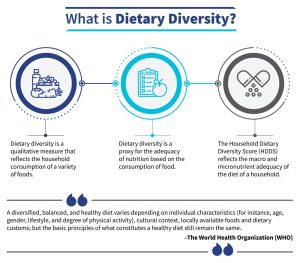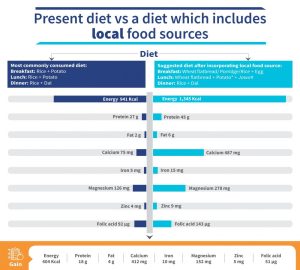An apple a day may not keep the doctor away—the importance of dietary diversity
by Neha Parakh, Puneet Khanduja, Mitul Thapliyal and Vijay Ravi
Jan 31, 2020
4 min
Based on a study conducted by MSC in August, 2019 to assess the nutritional gaps in PDS households, this blog highlights the importance of incorporating local and diverse food items into the beneficiaries’ diet
MSC undertook a study in July, 2019 to assess the nutritional gaps in households 1 served by the Public Distribution System (PDS)2. We conducted the study in Ranchi district of Jharkhand state and West Godavari district of Andhra Pradesh, India. The respondents of the study were women—most of them belonged to households where the primary breadwinner was a wage-laborer who carried out “heavy work”3. Our study revealed that the target populace severely lacked dietary diversity 4.
The respondents reported that staple grains, such as rice and wheat formed a large part of their daily food consumption with little to no inclusion of pulses, vegetables, meat, or fruit. Most respondents did not even consume dairy products.
Various socio-economic challenges hampered the dietary diversity of the respondents. The primary challenges were the availability and affordability of food. For example, dairy farming was not prominent in the region where we conducted our research and many fruit and vegetables were not cultivated locally. Despite the availability of low-cost diet alternatives in local markets, respondents were unaware of their nutritional importance.
In the table given below, we compare the nutritional outputs of the most commonly consumed diet to a diet that incorporates local food sources.
Note: All the values are calculated using standard recipes as stated by the National Institute of Nutrition (NIN).
*Replacing potato with local green leafy vegetables will further increase the nutritional intake significantly, even if it is three times a week.
#Jawa is a healthy drink made of Ragi (Eleusine coracana or finger millet) also known as Ragi malt.
The table highlights the importance of incorporating local and diverse food items5 into the diet.
People need to consume diverse food items to take advantage of the different nutritional benefits associated with them. Locally available food is an accessible and cost-effective option that results in better nutritional output without changing the dietary habits of the community. For instance, replacing rice with wheat flatbread (roti), potato with egg, and adding millet to the diet can contribute 404 kcal of extra energy. It also amounts to 18 g of extra protein, two times the fat, 412 mg additional calcium, 10 g of extra iron, 152 mg of additional magnesium, 5 mg of extra zinc, and 51 µg of additional folic acid. The outcomes would certainly be substantial if these changes are adopted regularly at the household level.
The existing PDS system is largely responsible for the lack of dietary diversity. PDS contributes to approximately 40%6 of the food grain7 consumed by an average beneficiary. MSC recommends that both the central and state governments should come together to implement policy-level changes to rectify the problem of inadequate dietary diversity. It is necessary to look beyond hunger and focus on nutrition as well. Existing channels that have a wide outreach, such as PDS, Integrated Child Development Services (ICDS), and the Mid-day Meal (MDM) initiative should be utilized to promote diversity in diets. The government should consider including local food items like millets, pulses, among others, in the PDS food basket as they cost less and have better nutritional components.
The availability and affordability of food items are the primary considerations that govern dietary choices. State governments should draw inspiration from the Government of Andhra Pradesh and a few other states that offer a range of food items in their PDS baskets. However, this will only take care of supply-side issues. Nutritional literacy8 is therefore essential to ensure the uptake of diverse food items in the PDS basket. The government should play a key role to enhance nutritional literacy by designing awareness and behavioral “nudge” campaigns to ensure an understanding of dietary diversity. We have examined the demand-side aspects of PDS in another blog in this series.
The intake of proper nutrition is essential for good health. A healthy person is more productive, makes fewer visits to the doctor, and relies less on supplements in their diet. Proper nutrition and dietary diversity produce cascading effects—a woman with a nutritious diet is more likely to give birth to a healthy baby, which paves the way to a healthy childhood. Similarly, a family with a well-rounded diet is more likely to be fit for work, happy, prosperous, and would save considerable amounts of money over time on healthcare costs.
Dietary diversification is a straightforward concept—consume a variety of food items to ensure the proper intake of various macro and micronutrients, which would result in a healthy life9. A wholesome diet need not be an expensive proposition or a luxury. Diversity can be incorporated through locally available options and eating traditional dishes. Even small changes in daily food choices can improve nutritional intake, at little or no additional cost.
References:
- Guidelines for measuring household and individual dietary diversity, FAO, 2013
- PDS covers more than 800 million people across India.
- Heavy work is intense manual work and sports activities—hand tilling the land, wood cutting, carrying heavy loads, running, and jogging, among others. The prescribed nutritional intake for adults depends on the nature of work conducted.
- Dietary diversity is defined as the number of different foods or food groups consumed over a given reference period
- Why we need to eat well?, FAO, 2004
- 40% is the contribution of PDS grains to an average beneficiary’s actual monthly grain consumption
- Grains are the base for all meals in India and the term food grains includes rice, wheat, pulses, millets
- Nutrition literacy may be defined as the degree to which people have the capacity to obtain, process, and understand basic nutrition information
- Dietary diversity is associated with child nutritional status: Oxford academic, 2004
Written by

Neha Parakh
Analyst
Puneet Khanduja
Senior Manager
Mitul Thapliyal
Partner
 by
by  Jan 31, 2020
Jan 31, 2020 4 min
4 min

Leave comments